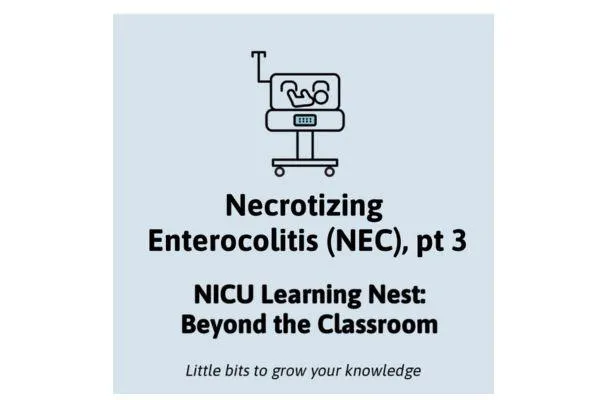
NEC Awareness Month – Part 3: Diagnosis, Treatment, and Long-Term Outcomes
NEC Awareness Month – Part 3: Diagnosis, Treatment, and Long-Term Outcomes
Welcome back to the final part of our NEC Awareness Month series! In Part 1, we discussed the risk factors and protective measures for necrotizing enterocolitis (NEC), and in Part 2, we focused on the early signs and symptoms every NICU nurse should watch for. Now, in Part 3, we’re diving into what happens when NEC is suspected or diagnosed—including the diagnostic tools used, the difference between medical and surgical NEC, common treatments, and possible long-term outcomes.
As NICU nurses, our role is essential not just in identifying NEC early, but also in executing the care plans that follow and in supporting families through every stage of this journey.
Medical vs. Surgical NEC
NEC can vary widely in severity, which is why accurate diagnosis is crucial. Some infants have medical NEC, where the disease is managed without surgery. Others may develop surgical NEC, requiring intervention to remove necrotic bowel tissue.
Diagnosis is made using a combination of clinical assessment, radiographic findings, and lab results. Ultrasound may be used alongside abdominal X-rays to evaluate bowel wall integrity and perfusion.
Modified Bell’s Staging Criteria for NEC
The Modified Bell’s staging system is a well-established tool to guide diagnosis and treatment. It ranges from Stage I (suspected NEC) to Stage III (advanced/severe NEC) and includes subcategories (e.g., 1a, 1b, 2a, 2b, etc.).
Key features assessed in staging include:
Abdominal signs (distention, tenderness, bowel loops)
Systemic signs (apnea, temperature instability, lethargy)
Radiographic signs (pneumatosis intestinalis, portal venous gas, pneumoperitoneum)
Lab abnormalities (metabolic acidosis, thrombocytopenia, neutropenia)
📖 Reference: PMC8096612
Treatment for Medical NEC
For infants with medical NEC, the goal is bowel rest and supportive care. This typically includes:
NPO status for 7–10 days
Replogle tube placement for decompression for a few days or until no output
Broad-spectrum antibiotics
Central line placement for nutrition and IV access
Serial abdominal X-rays every 6 hours in the first 24–48 hours or until stable
Close monitoring of vital signs, abdominal exams, fluid balance, and labs is critical during this phase.
Treatment for Surgical NEC: Bedside Drainage
Some infants, especially those who are extremely premature or unstable, may first undergo peritoneal drainage at the bedside to relieve intra-abdominal pressure and remove infected fluid. This may be used as a bridge to surgery or, in some cases, as the primary intervention. This is also common for spontaneous perforations, which is a different etiology than NEC.
Treatment for Surgical NEC: Laparotomy and Ostomy Creation
Surgical NEC often requires a laparotomy to remove necrotic bowel. If extensive bowel is affected, a temporary ostomy (e.g., ileostomy or colostomy) may be created to allow the remaining bowel to heal.
Diagnosis at this stage may be confirmed via:
X-ray findings (pneumoperitoneum, fixed dilated loops)
Ultrasound
Worsening clinical symptoms and assessment
Post-Operative Nursing Care
Post-op care focuses on:
Pain management (continuous infusions, PRNs, comfort measures)
Fluid and electrolyte balance
Monitoring for:
Hypotension
Acidosis
Ongoing sepsis
Ileus or bowel function return
NICU nurses play a critical role in coordinating care and identifying early complications after surgery.
Ostomy Care in the NICU
Ostomy care requires:
Frequent skin assessments
Use of barrier pastes and wafers to protect delicate skin
Monitoring for prolapse, retraction, or signs of poor perfusion
Educating and involving parents early in ostomy care to reduce fear and prepare them for eventual home care
Long-Term Outcomes After NEC
While many infants recover fully, some experience long-term complications, including:
Short bowel syndrome
Poor weight gain or feeding intolerance
Developmental delays
Chronic diarrhea or strictures
Emotional and psychological stress for families
Early intervention, nutrition support, and multidisciplinary follow-up are vital for optimizing outcomes.
Recap – NEC Awareness Month
Over the past three weeks, we’ve taken a deep dive into necrotizing enterocolitis—from the risk factors to recognition, through treatment and long-term outcomes. We reviewed the Modified Bell’s staging criteria, the difference between medical and surgical NEC, and the crucial nursing care that supports each phase of this journey. NEC is one of the most serious conditions we face in the NICU, but with education and early action, we can make a lasting difference in outcomes for our patients and their families.
💛 Be sure to check out Part 1: NEC Risk Factors and Part 2: Early Signs and Symptoms if you haven’t already!
Thank you for growing your NEC knowledge with me! 💛
